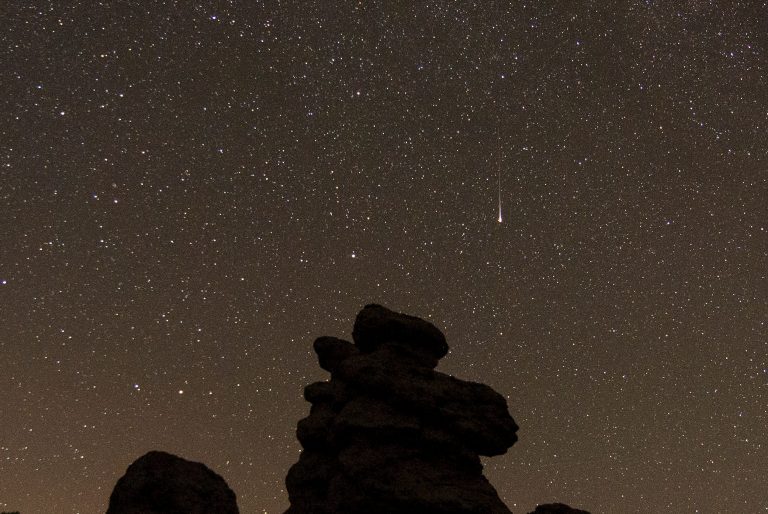On April 13, U.S. officials confirmed that a small meteorite that splashed down into the ocean near Papua New Guinea in 2014 was in fact a meteor that traveled from another solar system, making it the first object ever detected from interstellar space. Previously, ‘Oumuamua, an interstellar object dejected passing through the solar system in 2017, was thought to be the first interstellar object detected in the solar system.
The meteor, which is estimated to be approximately a meter in size, is now both the first known interstellar object to enter the solar system and the first confirmed interstellar object to strike Earth.
The meteor dubbed CNEOS 2014-01-08, that crashed-down on Jan. 8, 2014 was identified as an interstellar object in a 2019 study written by an undergraduate student at Harvard University, Amir Siraj, and famed theoretical physicist Abraham “Avi” Loeb.
The discovery was confirmed to be an interstellar object by the U.S. Space Command in a document tweeted out on April 6.
The document, signed by Deputy Commander John E. Shaw states, “As you may be aware, Dr. Amir Siraj and Dr. Abraham Loeb of the Department of Astronomy of Harvard University authored a paper titled Discovery of a Meteor of Interstellar Origin. This paper identified a meteor detected on 2014-01-08 at 17:05:34 UTC. The paper reported the meteor as originating from an unbound hyperbolic orbit (defined as interstellar space hereafter) with 99.999% confidence. This event would predate the discovery of ‘Oumuamua by about 3 years.”
Success
You are now signed up for our newsletter
Success
Check your email to complete sign up
Siraj wrote extensively about his and Loeb’s discovery in an opinion article published to Scientific America on April 12.
In it he wrote, “A high-speed fireball that struck Earth in 2014 looked to be interstellar in origin, but verifying this extraordinary claim required extraordinary cooperation from secretive defense programs.”
Siraj wrote that when the meteor entered Earth’s atmosphere it burned up with an energy equivalent to about 110 metric tons of TNT. He conceded that similar-sized fireballs are not uncommon and occur a few dozen times a year but what made this event unusual was the “very high speed and unusual direction at which it encountered our planet, which collectively suggested it came from interstellar space.”
US government satellite the ‘sole witness’
The team of researchers encountered barriers to their research however due to the fact that sensors on a classified U.S. government satellite — designed to detect foreign missile launches — was the “sole witness” to the fireball.
“Thanks to a partnership between the Department of Defense and NASA, the data describing the event eventually were shared on a public database hosted by the Center for Near Earth Object Studies (CNEOS) within the space agency’s Jet Propulsion Laboratory, along with data for more than 900 other fireballs recorded by U.S. government sensors between 1988 and present-day,” Siraj wrote.
The data shared included dates, times, latitudes, longitudes, altitudes, speeds, three-dimensional velocity components, and energies for each but omitted the uncertainties for most of the measurements, “presumably to ensure the precision thresholds for U.S. global sensing capabilities are not divulged, as this information could potentially be exploited by adversaries.”
Siraj asserts that any object traveling faster than 42 kilometers per second is considered to be in an “unbounded, hyperbolic orbit relative to our star,” meaning that it is moving too fast to be captured by the sun’s gravity.
According to Siraj, “Anything traveling over this local celestial speed limit, then, may come from (and if unimpeded should return to) interstellar space.”
The meteor is estimated to have hit Earth’s atmosphere at about 45 kilometers per second, however when accounting for the fact that the object had overtaken the Earth from behind before striking Earth’s atmosphere the object could have been traveling as fast as 60 kilometers per second.
The ‘fascinating consequences’ of the discovery
Siraj says that the object’s interstellar nature carries with it “fascinating consequences.”
First, its size implies “that each star needs to contribute a significant mass of similar objects over its lifetime to make the 2014 detection likely,” implying that there are numerous other interstellar meteors to be found.
Second, its high speed, relative to the average speeds of neighboring stars, suggests that the object was ejected from deep within another planetary system.
Siraj says that the “holy grail” of interstellar object studies would be to actually obtain a physical sample of a meteor, a goal that Siraj says would be both “audacious” and “scientifically groundbreaking.”
He said, “We are currently investigating whether a mission to the bottom of the Pacific Ocean off the coast of Manus Island, in the hopes of finding fragments of the 2014 meteor, could be fruitful or even possible.”
Barring this, Siraj says that he is excited to also be pursuing a spacecraft rendezvous.
“In collaboration with Alan Stern, the principal investigator of NASA’s New Horizons mission, we have now received funding to develop a concept for a space mission to some future interstellar object,” Siraj wrote.
















